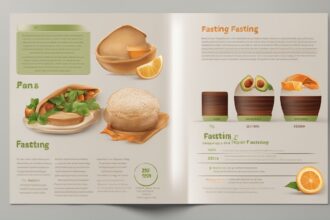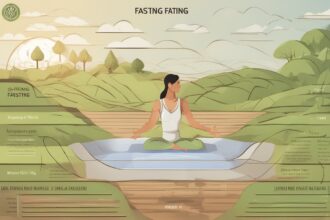Have you ever wondered if going without food for days could actually be good for you? Extended fasting, a practice that involves abstaining from food for 24 hours or more, has gained traction in recent years as a powerful tool for health optimization. Unlike intermittent fasting, which cycles between short eating and fasting windows, extended fasting pushes the body into deeper metabolic states with potential benefits like weight loss, improved mental clarity, and even cellular repair. But it’s not without risks, and diving into a prolonged fast without preparation can be daunting—or even dangerous. In this comprehensive guide, we’ll explore what extended fasting is, its science-backed benefits, potential drawbacks, and how to create a safe and effective plan. Whether you’re a curious beginner or a seasoned faster, let’s unpack everything you need to know about extended fasting and how it could transform your health journey.
What Is Extended Fasting?
Extended fasting refers to voluntarily abstaining from caloric intake for periods longer than 24 hours, often ranging from 2 to 7 days or more. This isn’t just skipping breakfast—it’s a deliberate choice to push your body beyond the typical fasting window to tap into deeper physiological changes. During an extended fast, the body shifts from using glucose as its primary fuel to burning stored fat through a process called ketosis. After about 48–72 hours, many people also experience autophagy, a cellular “clean-up” process where the body recycles damaged cells and proteins (Levine & Kroemer, 2019). This practice isn’t new; humans have fasted for centuries for religious, cultural, or survival reasons. Today, it’s often used for health goals like weight management, metabolic health, or even longevity.
What sets extended fasting apart from other fasting methods, like the popular 16:8 intermittent fasting, is the duration and intensity. It’s not a quick reset but a deeper dive into your body’s adaptive mechanisms. However, this also means it requires more planning and caution. So, how does prolonged fasting work on a biological level, and what can you expect?
The Science Behind Extended Fasting Benefits
The buzz around prolonged fasting
Research also suggests that extended fasting can improve insulin sensitivity, making it a potential tool for managing type 2 diabetes or metabolic syndrome (Anton et al., 2018). Some studies even point to benefits for brain health, with fasting showing promise in enhancing cognitive function and protecting against neurodegenerative diseases (Mattson et al., 2017). Weight loss is another obvious perk, as prolonged calorie restriction naturally reduces body fat—though it’s not a magic bullet and must be paired with sustainable habits. While these benefits sound promising, it’s worth noting that much of the research is still emerging, and long-term effects are not fully understood. So, while the science is exciting, it’s not a one-size-fits-all solution.
Potential Risks and Challenges of Prolonged Fasting
Before jumping into an extended fasting plan, it’s critical to understand the risks. Going without food for days isn’t a walk in the park, and it can stress the body if not done correctly. Common side effects include fatigue, dizziness, headaches, and irritability—often called the “keto flu” as your body adjusts to ketosis. More serious risks include electrolyte imbalances, especially if you’re not hydrating properly or replenishing minerals like sodium and potassium (Johnstone, 2015). For some, extended fasting can also trigger disordered eating patterns or exacerbate existing medical conditions like diabetes or heart issues (Trepanowski & Bloomer, 2010).
Who should avoid extended fasting? If you’re pregnant, breastfeeding, underweight, or managing a chronic illness, this practice may not be safe without medical supervision. Even healthy individuals can struggle with hunger pangs, low energy, or mental fog during a prolonged fast. The key takeaway? Extended fasting isn’t for everyone, and listening to your body is non-negotiable. So, how can you minimize these risks and set yourself up for success?
How to Start an Extended Fasting Plan Safely
If you’re intrigued by the idea of long-term fasting, the first step is to approach it with a clear plan and realistic expectations. Rushing into a 5-day fast without preparation is a recipe for discomfort—or worse. Instead, ease into it by building a foundation with shorter fasts. Start with a 16:8 intermittent fasting schedule for a few weeks, then try a 24-hour fast before progressing to 48 hours or more. This gradual approach helps your body adapt to longer periods without food and reduces the shock to your system.
Preparation is everything. Before starting, consult a healthcare provider, especially if you have underlying conditions or take medications. During the fast, focus on hydration—drink plenty of water and consider adding a pinch of salt or electrolyte supplements to prevent imbalances (Johnstone, 2015). Break your fast gently with light, easily digestible foods like broth or small portions of vegetables to avoid digestive distress. Here are some practical tips to keep in mind when crafting your extended fasting routine:
- Start small: Build up from shorter fasts to longer ones over weeks or months.
- Stay hydrated: Aim for at least 2–3 liters of water daily during your fast.
- Monitor symptoms: Stop if you feel dizzy, weak, or unwell, and seek medical advice.
- Plan rest: Avoid intense exercise during extended fasts; opt for light activities like walking.
- Break wisely: Reintroduce food slowly with nutrient-dense, low-sugar options.
Sample Extended Fasting Schedules for Beginners
Not sure where to start with your extended fasting protocol? Having a structured schedule can make the process less intimidating and more sustainable. The right plan depends on your experience level, lifestyle, and health goals. Below, I’ve outlined a few beginner-friendly extended fasting schedules to help you dip your toes into longer fasting periods. Remember, these are just starting points—adjust them based on how your body responds and always prioritize safety.
- 48-Hour Fast (Beginner): Fast for two full days once a month, drinking only water, black coffee, or herbal tea. Break the fast with a small meal of soup or steamed veggies.
- 3-Day Fast (Intermediate): After mastering shorter fasts, try a 72-hour fast every 6–8 weeks. Include electrolytes in your water to support energy levels.
- 5-Day Fast (Advanced): For experienced fasters, a 5-day fast can be done quarterly under medical supervision, focusing on deep rest and minimal stress.
These schedules aren’t set in stone. Some people thrive on a 48-hour fast weekly, while others prefer a longer fast less often. The key is to experiment cautiously and track how you feel—energy levels, hunger, and mood all provide clues about what works for you. And remember, fasting isn’t a competition; longer doesn’t always mean better.
Who Should Consider Extended Fasting—and Who Shouldn’t?
Extended fasting can be a game-changer for some, but it’s not a universal fix. If you’re looking to reset your metabolism, manage weight, or explore potential benefits like improved focus or reduced inflammation, a carefully planned prolonged fasting regimen might be worth considering. People with stable health, no major medical conditions, and a solid understanding of nutrition often fare best with this practice. However, it’s not a casual diet trend—it requires commitment and self-awareness.
On the flip side, certain groups should steer clear or proceed only under strict medical guidance. If you’re dealing with low blood sugar, eating disorders, or nutrient deficiencies, extended fasting could do more harm than good (Trepanowski & Bloomer, 2010). Children, teens, and older adults with frailty concerns should also avoid prolonged fasts due to higher risks of adverse effects. Ultimately, personalized advice from a doctor or dietitian is invaluable before embarking on this journey. Fasting is powerful, but only when it’s the right fit for your body and lifestyle.
As we’ve explored, extended fasting offers a fascinating mix of potential health benefits and challenges. From triggering autophagy to supporting weight loss and metabolic health, the science behind prolonged fasting is compelling, even if it’s still evolving. But it’s not a quick fix or a carefree experiment—it demands preparation, patience, and a willingness to listen to your body. If you’re ready to try an extended fasting plan, start slow, stay hydrated, and don’t hesitate to seek professional guidance. Remember, health isn’t about extremes; it’s about finding balance. So, whether you’re aiming for a 48-hour reset or a longer fast, approach it with curiosity and care. Have you tried extended fasting before, or are you just starting to explore it? Drop your thoughts or questions below—I’d love to hear about your journey!
References
- Anton, S. D., Moehl, K., Donahoo, W. T., Marosi, K., Lee, S. A., Mainous, A. G., … & Mattson, M. P. (2018). Flipping the metabolic switch: Understanding and applying the health benefits of fasting. Obesity, 26(2), 254-268. https://doi.org/10.1002/oby.22065
- Johnstone, A. (2015). Fasting for weight loss: An effective strategy or latest dieting trend? International Journal of Obesity, 39(5), 727-733. https://doi.org/10.1038/ijo.2014.214
- Levine, B., & Kroemer, G. (2019). Biological functions of autophagy genes: A disease perspective. Cell, 176(1-2), 11-42. https://doi.org/10.1016/j.cell.2018.09.048
- Mattson, M. P., Longo, V. D., & Harvie, M. (2017). Impact of intermittent fasting on health and disease processes. Ageing Research Reviews, 39, 46-58. https://doi.org/10.1016/j.arr.2016.10.005
- Trepanowski, J. F., & Bloomer, R. J. (2010). The impact of religious fasting on human health. Nutrition Journal, 9(1), 57. https://doi.org/10.1186/1475-2891-9-57






